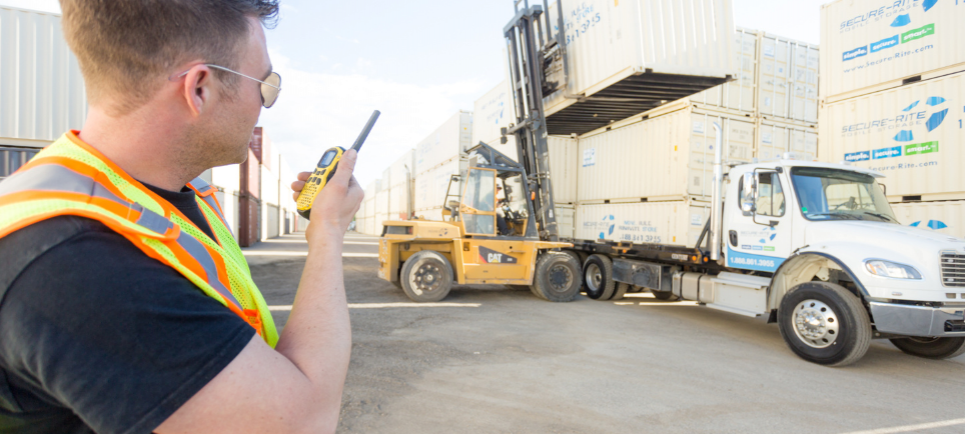
Safe Driving Tips - Sharing the Road with Commercial Trucks
by Secure-Rite
Navigating the highways alongside commercial trucks can be a daunting task. Ryan Groenheyde, our in-house expert on occupational health and safety at Secure-Rite Mobile Storage, offers his insights and safe driving tips to keep both professional drivers and everyday commuters safe on the road.
Why Distance Matters
When it comes to stopping a vehicle, the laws of physics are non-negotiable. The heavier the vehicle, the greater the stopping power required. But speed complicates this equation exponentially. A large truck's stopping distance can be up to eight times that of a car or more. The cargo they carry remains a mystery to fellow drivers, adding an element of unpredictability to the mix. It's crucial for everyone driving to understand that large commercial trucks take a much longer time to stop completely.
The Three-Second Rule and Beyond
Under clear skies on a dry road, maintaining a three-second gap between you and the vehicle ahead is a good starting point, according to ICBC. But why stop there? For large trucks, the following distance should be considerably increased, especially in winter conditions!
Finding your safe distance on the road is as simple as picking a fixed point that the truck ahead passes—a signpost or a tree will do. Count the seconds it takes for you to reach the same point. Less than three? You're too close for comfort.
On the road, safety is synonymous with space. The space you keep can be the buffer between a regular drive home and a dangerous situation.
Ryan's parting wisdom:
The few seconds you give today can mean years of shared moments tomorrow.
- Ryan Groenheyde
Calm Roads Ahead: The New Pace of Trucking
Navigating the roads with mindfulness can turn a routine commute into a calm retreat. The latest regulations coming into effect this year underscore this, capping the speed of large trucks at 105 km/h in any weather, fostering a safer environment for all. This enforced deceleration is more than mere regulation—it's a proactive step towards avoiding accidents and an invitation to all road users to take a deep breath, embrace patience, and appreciate the journey. After all, slower speeds mean clearer thinking, better reaction times, and an overall smoother ride. It’s a shared step towards safer, more considerate driving habits that benefit everyone on the road.
Turning Tactfully: Understanding Trucks Turning Rights
Acknowledging the legal and physical necessities of truck navigation sharpens our own driving acumen. Trucks are legally permitted to make wide turns and may need to cross into adjacent lanes to accommodate their length and ensure safety. This is a privilege specific to large vehicles due to their size. For standard vehicles, the rule is to turn into the closest lane. A wise rule for drivers is to avoid turning alongside a truck. Granting them their needed space isn't just courteous—it's a critical aspect of road-sharing etiquette that upholds safety and legality.
Why Cutting In Front Isn't Cutting It
The seemingly large gap before a large truck at a stoplight is deceptive; it's a carefully calculated buffer by the driver to halt without haste. When a car darts into this space, it abruptly alters the equation, forcing the truck to an urgent stop — a scenario that can spell danger. Heavy loads and physics can conspire against the most talented driver, so preserving this zone is vital. Respecting a truck's space at stoplights isn't just considerate; it's a move that contributes to the safety of all drivers. It is also important to understand that the space left by commercial vehicles during transit is also intended as a safety zone, not an opening for you to squeeze into.
The Invisible Risk: Understanding Truck Blind Spots
Have you ever noticed the sign on the back of a truck: "If you can't see my mirrors, I can't see you"? Well, it's absolutely true. Driving too close to a truck not only hides you from view, but puts you at risk of damage from road debris. Rocks and gravel can be thrown up by a truck's large tires, striking your vehicle with surprising force. In wet conditions, the back-splash from a truck's tires can drench your windshield with dirt and slush, suddenly impairing your visibility. It's not just about keeping a distance; it's about safeguarding your journey from these unseen roadside hazards.
Each driver plays a pivotal role in the collective safety on our roads. By embracing these safe driving tips and understanding the nuances of driving alongside commercial vehicles, you become an ally in the mission for safer travels. Secure-Rite commends you for joining us in this vigilant practice. Together, with our fleet setting the standard, we thank you for doing your part. Remember, the few seconds you give today can mean years of shared moments tomorrow. Here's to the roads that lead us home, made safer by drivers like you.
Reach out if you need a storage container in Kelowna, or any of our other locations:
Kelowna | Penticton | Vernon | Vancouver | Calgary | Prince George
ABOUT SECURE-RITE MOBILE STORAGE
Secure-Rite brings people and portable space together in creative and meaningful ways and strives to change the way the world views and uses shipping containers.

